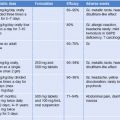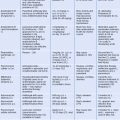CHAPTER 26 Chagas’ Disease (American Trypanosomiasis)
Epidemiology
The flagellate protozoan Trypanosoma cruzi is the cause of Chagas’ disease (American trypanosomiasis), a zoonotic infection of approximately 10–12 million persons and over 100 species of wild and domestic animals in the Americas.3,8 Most infected persons living today acquired infection from the triatomine vector, which in different countries is called by such names as vinchuca, barbeiro, chinche, kissing bug, or cone-nosed bug. Triatomine bugs transmit the parasite when they take a blood meal from sleeping persons. As a rule, bugs colonize only poorly constructed houses such as those made of mud and stick, thatch, or adobe. For this reason, Chagas’ disease traditionally has been a disease of poor persons living in rural areas or urban slums in Latin America.
Highly successful control programs in the past 10–15 years have interrupted or greatly reduced vector-borne transmission in several countries, most dramatically in the Southern Cone and Venezuela.3 The Andean and Central American countries and Mexico recently initiated vector control programs with the goal of interrupting transmission within a decade.
Trypanosoma cruzi can also be transmitted from an infected pregnant mother to her developing fetus or from an infected donor of blood products or organ transplant to the recipient. Congenital infection occurs in 1% to greater than 7% of pregnancies among women with chronic infection.2,9 In the early 1980s, over 20 000 cases of transfusion-associated infections occurred each year in South America. The incidence of such infections has declined dramatically, because serological screening of donors is now required by law throughout Latin America.9 However, screening tests may not be reliable in some blood donation centers, and several countries instituted mandatory screening only in recent years.
Millions of immigrants from countries where Chagas’ disease is endemic are living in the United States, Canada, Europe, and other industrialized countries. Based on serological surveys of blood donors and immigrant populations, estimates of the number of immigrants with T. cruzi infection living in the United States range from 50 000 to over 120 000.5,7,9 The majority of infected persons are asymptomatic, and few are aware that they are infected.4 Not surprisingly, there have been six reports of transfusion-associated transmission and three episodes of transplant-associated transmission in the United States. Universal screening of blood and organ donors for T. cruzi infection is not mandatory in the United States and other nonendemic countries but the United States Red Cross began screening in January 2007. As screening becomes routine healthcare providers will need to learn how to care for the large numbers of asymptomatically infected immigrants who will be detected.
Clinical Manifestations
It would be exceedingly unusual for a recently arrived immigrant to present with manifestations of acute Chagas’ disease. Coincidental acquisition of infection within a few months of departure has become increasingly improbable because of effective control programs in many endemic countries. Moreover, most acute infections are subclinical.8 During the acute stage of infection, less than 10% of persons experience a febrile illness, and less than 1% becomes seriously ill with acute myocarditis or meningoencephalitis.
The manifestations of Chagas’ esophageal disease are identical to those of idiopathic achalasia: progressive dysphagia and dilation of the esophagus that can reach massive dimensions. Persons with Chagas’ megaesophagus experience repeated episodes of aspiration pneumonia and become severely malnourished. Those with Chagas’ megacolon, which resembles Hirschsprung disease, go weeks to months between bowel movements and are at risk of developing volvulus of the colon.
Intracellular replication and levels of parasitemia increase when chronically infected persons develop AIDS, receive immunosuppressive medications, or suffer from other conditions that compromise cellular immunity.9 The most common manifestation of reactivated infection is meningoencephalitis, with fever, headache, seizures, focal neurological signs, and enhancing hypodense lesions on computed tomography (CT) or magnetic resonance imaging (MRI) similar to those of central nervous system toxoplasmosis. Other presentations include acute myocarditis and subcutaneous nodular lesions.
Stay updated, free articles. Join our Telegram channel

Full access? Get Clinical Tree







